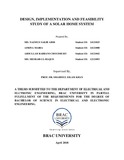| dc.contributor.advisor | Khan, Dr Shahidul Islam | |
| dc.contributor.author | Abir, Md. Nazmus Sakib | |
| dc.contributor.author | Choudhury, Abdullah Rabbani | |
| dc.contributor.author | Maria, Afrina | |
| dc.contributor.author | Haque, Md. Mesbah-Ul- | |
| dc.date.accessioned | 2018-05-08T07:55:01Z | |
| dc.date.available | 2018-05-08T07:55:01Z | |
| dc.date.copyright | 2018 | |
| dc.date.issued | 2018-04 | |
| dc.identifier.other | ID 14121025 | |
| dc.identifier.other | ID 14121008 | |
| dc.identifier.other | ID 14121042 | |
| dc.identifier.other | ID 12121093 | |
| dc.identifier.uri | http://hdl.handle.net/10361/10012 | |
| dc.description | This thesis is submitted in partial fulfilment of the requirements for the degree of Bachelor of Science in Electrical and Electronic Engineering, 2018. | en_US |
| dc.description | Catalogued from PDF version of thesis. | |
| dc.description | Includes bibliographical references (page 70-72). | |
| dc.description.abstract | Electricity is one of the greatest blessing of the world. It has made impossible things possible. Regrettably there are approximately 1.3 billion people who are deprived of this blessing. Most of these people are the people from the underdeveloped and developing country. Being a developing country, Bangladesh is facing the same problem. Solar Home System (SHS) can resolve this problem as a renewable energy. The aim of this project is to study and implement a Solar Home System (SHS). This project can be divided two portions. Firstly, the implementation of the thesis project was done by designing and installing a 100 watt-peak solar home system. The further works were divided by the simulation process through software.
This study also includes Data logging, Cost Efficiency, analysis by RETscreen 4.0 and PVsyst to monitor the viability of this project. The information of the solar panel output voltage, efficiency of the panel, load pressure on panel, daily solar irradiation can be obtained from data logging. Phocos CXN charge controller has data logging capacity whilst being a charge controller. The cost effectiveness of SHS is the first and foremost concern for engineers. While calculating cost efficiency including geographical and representation of the cost of this system over the life cycle. Before implementing the system, PVSyst software has been used for simulation of the project and so the viability of the system has been assured virtually. These data were compared with other existing systems to increase the system efficiency, bearing the cost and geographical information in mind. The illumination of flood light has been observed to get profound data to implement this system in urban and rural residential area.
The load we used in the system have lower capacity than the actual capacity of the system. In fact, the load was provided with sufficient energy form the panel and there was no loss of load. More than 60% energy was unused. The utilization of this unused energy can be ensured by controlling more loads to the system in future. | en_US |
| dc.description.statementofresponsibility | Md. Nazmus Sakib Abir | |
| dc.description.statementofresponsibility | Abdullah Rabbani Choudhury | |
| dc.description.statementofresponsibility | Afrina Maria | |
| dc.description.statementofresponsibility | Md. Mesbah-Ul-Haque | |
| dc.format.extent | 90 pages | |
| dc.language.iso | en | en_US |
| dc.publisher | BRAC Univeristy | en_US |
| dc.subject | Solar home system | en_US |
| dc.subject | Renewable energy | en_US |
| dc.title | Design, implementation and feasibility study of a solar home system | en_US |
| dc.type | Thesis | en_US |
| dc.contributor.department | Department of Electrical and Electronic Engineering, BRAC University | |
| dc.description.degree | B. Electrical and Electronic Engineering | |
| dcterms.rights | BRAC University theses are protected by copyright. They may be viewed from this source for any purpose, but reproduction or distribution in any format is prohibited without written permission. | |

